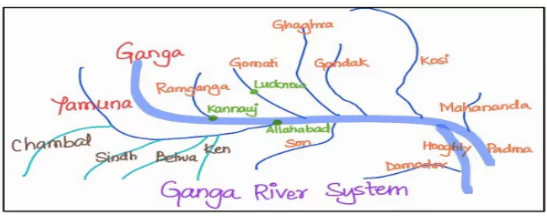![]() May 4, 2024
May 4, 2024
![]() 10390
10390
![]() 0
0
The Ganga river has a length of 2,525 km. It is shared by Uttarakhand (110 km) and Uttar Pradesh (1,450 km), Bihar (445 km) and West Bengal (520 km). Ganga basin covers the states of Uttar Pradesh, Madhya Pradesh, Rajasthan, Bihar, West Bengal, Uttarakhand, Jharkhand, Haryana, Chhattisgarh, Himachal Pradesh and Union Territory of Delhi draining nearly 26% of the total geographical area of the country.
 Origin: Nepal Himalayas between the Dhaulagiri and Mount Everest and drains the central part of Nepal.
Origin: Nepal Himalayas between the Dhaulagiri and Mount Everest and drains the central part of Nepal. A. Yamuna
B. Son
C. Damodar
| Must Read | |
| Current Affairs | Editorial Analysis |
| Upsc Notes | Upsc Blogs |
| NCERT Notes | Free Main Answer Writing |
The Ganga River, with its extensive course and numerous tributaries, plays a very important role in the geography and culture of India. The Ganga basin, spanning across multiple states, forms a crucial part of India’s ecosystem. Its tributaries, like the Yamuna and Ghaghara, add to its majesty and significance. Understanding its course and tributaries helps us appreciate the rich natural heritage and the interconnectedness of ecosystems in the Indian subcontinent.
| Related Articles | |
| The Ganga River System: Exploring India’s Waterways | Indian Geography: Location and Overview |
| River Systems of India | Ecological Threat Report 2023 |
<div class="new-fform">
</div>
Latest Comments